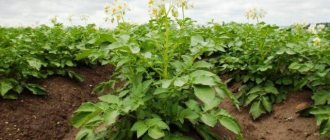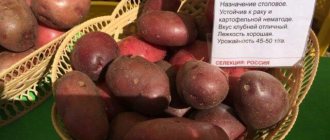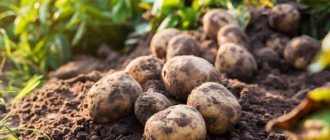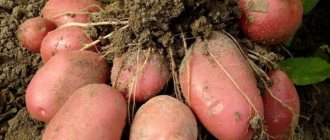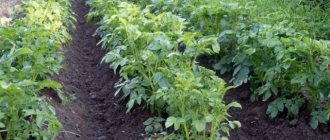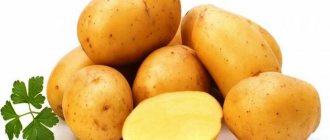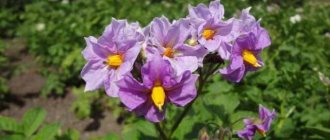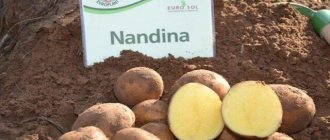History of appearance
The Svitanok Kyiv potato was bred in Ukraine by specialists from the Institute of Potato Growing of the local Academy of Agricultural Sciences. This organization is listed as the originator (along with the Russian LLC Litvinovskoye). A whole team of breeders worked on the creation of a new variety, all of them are listed as authors.
The Svitanok Kyiv potato was included in the State Register of Breeding Achievements of the USSR in 1987. The necessary official variety trials took five years. Now the variety continues to be listed in the Russian State Register.
Basic growing rules
For sowing, you should choose soil with a high content of sandy substances. Also, do not forget that you should regularly change the crop areas. When the soil is resting from potatoes, vegetables should be planted in it that can nourish the soil with useful microelements. Such vegetables are radishes and legumes.
The seeds cannot degenerate, so they are often used for several years. This does not in any way affect the yield. There is no need to worry about stimulating plant growth with additional substances. It rises just fine on its own. It is recommended to plant Svitanok Kiev at the end of April or early May.
After the first shoots begin to appear, 70-80 days should be counted. It is at this moment that you can safely begin harvesting. But, it is best to wait 90 days. It is during this period of time that the highest yields are observed.
This species responds quite well to various feedings. You need to ensure that the soil is moist, but not very wet. During the entire period of fruit ripening, you should fertilize the soil 3 times. You can use cow or bird droppings for this. You can also use mineral fertilizers.
It is important to remember that all fertilizing should be carried out only before you are going to actively water the soil. It should also be noted that this type of potato needs to be hilled 2 times and weeded every 2 weeks and weeds removed.
Description of the potato variety Svitanok Kyiv
The tubers of the Svitanok Kyiv potato look quite presentable. And the relatively small size of the bushes is another plus, especially for owners of the standard “six hundred square meters”.
Bush
Potato bushes Svitanok Kyiv are low (about 50 cm), “squat”, relatively compact. The stems are medium thick, but erect, rarely lying on the ground. The foliage is medium, the leaf blades are medium-sized, slightly wrinkled. Flowering is abundant, but short-lived. The corollas are large, bright lilac.
The root system of the bushes is powerful and well developed
Tubers
Svitanok Kyiv potato tubers are medium in size, weighing 90-120 g. The shape can be either round-oval or irregular. The skin is pink, thin, but strong and elastic - this provides the variety with good shelf life and transportability. Darker, red-crimson “eyes” stand out against the general background. They are small and superficial, so peeling the tubers is easy.
The flesh of the Svitanok Kyiv potato is pale yellow or creamy. After heat treatment it does not darken. There is not a hint of “starchiness” or wateriness in the pulp; the texture seems to be oily.
There are very few “little things” in the nests, the percentage of marketable tubers is 96%
Description and characteristics
Detailed information about this variety is given below.
Description of tops and root crops
The bush consists of upright growing stems gathered together, which are moderately covered with green mass. Medium sized foliage. Blooms profusely with purple or red flowers. The root system is well developed; from 8 to 12 oval tubers are formed on one plant. The weight of one potato reaches 90-120 g.
The warmer the climate, the earlier the tubers ripen
The surface of the tuber is covered with a thin, light pink peel with small eyes, which are colored several shades darker. The pulp is light - creamy white. Root vegetables contain about 18-19% starch, due to which they have a rich, non-watery taste, during heat treatment they acquire a delicate and crumbly consistency, and also retain color.
Productivity
If all agrotechnical standards are observed, it is possible to collect about 460 centners of root crops from 1 hectare. The average yield is at the level of 250-300 c/ha.
Harvest ripening time
The growing season lasts from 85 to 105 days.
Svitanok Kiev is a fairly popular type of potato in many countries around the world.
Immunity to disease
At the genetic level, the variety is resistant to the following diseases:
Characteristics of potatoes Svitanok Kyiv
A significant advantage of the Svitanok Kyiv potato over its “competitors” is its outstanding taste. But this is not the only varietal characteristic that needs to be taken into account when choosing a variety or hybrid for yourself.
Taste qualities
The taste qualities of Svitanok Kyiv potatoes are characterized as “good” or “excellent”. According to the culinary classification, potatoes belong to type C. This category includes varieties with a high starch content. They are suitable for making purees and various fillings for baking, stewing, roasting, and stuffing.
During frying or cooking soup, the tubers “fall apart” or turn into an unappetizing porridge.
Important! Short drought, temperature changes, waterlogging of the soil and other negative factors have virtually no effect on the taste of Svitanok Kyiv potatoes and their richness.
Ripening time
Svitanok Kyiv is a mid-early potato variety. Tubers are dug up 85-105 days after mass germination. The ripening time of the crop depends on the local climate and weather during the summer. In the warm southern regions it is even slightly shorter than the “official” one (75-80 days), so there the Svitanok Kyiv potato can be classified as an early-ripening variety.
Productivity
The Svitanok Kyiv potato is not very popular among professional farmers. However, the existing experience in its cultivation allows us to assert that the average yield of the variety when grown on an industrial scale is 250-300 centners per hectare, and the record one is more than 450 centners / ha.
Amateur gardeners, providing Svitanok Kievskiy potatoes with competent care, receive up to 300 kg per 100 m². The average yield is 180-200 kg per hundred square meters.
Important! Potatoes Svitanok Kyiv in optimal or close to optimal conditions are distinguished by very high preservation of tubers - about 95%.
9-12 tubers are formed in one “nest”
Growing regions
Initially, Svitanok Kyiv potatoes were intended for cultivation in regions with a temperate climate (Central region, Volga region). However, the State Register officially recognizes it as suitable for more severe conditions - the North-Western region, Western Siberia, the Far East, and the Urals. The Svitanok Kyiv potato is also actively cultivated in its homeland - there it has also “taken root” very successfully and is considered practically a standard one. It is also highly appreciated by gardeners in Moldova and Belarus.
Disease resistance
The creators have provided Svitanok Kyiv potatoes with immunity to bacterial cancer and rhizoctonia. It has good resistance to various types of mosaic virus, blackleg and scab. The most dangerous for the variety is late blight in both forms and the leaf curl virus.
As for pests, gardeners do not note any particular love for the Svitanok Kyiv potato from the Colorado potato beetle. Although, during “massive” attacks on the garden, bushes of this variety will not be ignored. There is also information from the originator, according to which the Svitanok Kyiv potato is relatively resistant to the golden cyst nematode.
Bushes affected by late blight quickly dry out, the above-ground part dies off
Final part
Svitanok Kiev is a fairly popular type of potato in many countries around the world. It is used not only for personal use, but also in industrial enterprises. After all, it produces excellent dishes that have a unique, pleasant taste.
It can also be transported over long distances without fear of it losing its presentation. The shelf life can reach 3-4 months. The description of this variety deserves the attention of every gardener who has not yet decided on the potato variety to grow in their beds.
Advantages and disadvantages
The outstanding taste of Svitanok Kyiv potatoes is recognized even by professional tasters. From them he received the highest possible score - 5 points.
Potatoes Svitanok Kyiv have a rich chemical composition
Pros:
- suitability of the variety for cultivation in most Russian regions;
- minimal “susceptibility” to the negative influence of weather factors;
- low maintenance requirements;
- relatively early and “friendly” harvest ripening;
- presence of immunity and good resistance to diseases;
- resistance of planting material to degeneration;
- compactness of bushes, possibility of compacted plantings;
- external presentability of tubers;
- almost complete absence of “trifles”;
- very good keeping quality, transportability and preservation of potatoes;
- outstanding taste of tubers;
- Suitable for preparing many dishes.
Minuses:
- relatively low yield;
- tendency to be affected by late blight, leaf curl virus;
- unsuitability of tubers for frying and cutting in boiled form.
Characteristics of the variety
Svitanok Kiev is a potato variety that was bred by breeders from Ukraine. It is ideal for those areas that have temperate or continental climate conditions. Most of all it is grown in Ukraine, Moldova, Russia and Belarus.
This variety of potatoes can be used to prepare any dishes. Due to the fact that it contains a large amount of starch and protein compounds, it has excellent taste. Moreover, it is very useful, as it contains mineral compounds that have a beneficial effect on the human body. It does not require special care and tolerates farmer mistakes well. This potato variety can be planted several times and the end result will not change in any way. There is no need to update seed material every year. Despite the high level of resistance to negative influences, it can be susceptible to viruses.
Landing rules
Potatoes Svitanok Kyiv prefers relatively light soils, with a fairly high percentage of sand in the composition. Other criteria for choosing a place for a garden bed are good lighting, the absence of groundwater close to the surface of the earth, and a neutral or slightly acidic pH.
In central Russia, Svitanok Kyiv potatoes are planted in the first ten days of May. In the south - 2-3 weeks earlier. In regions with harsher climates, you sometimes have to wait until early June. The substrate at a depth of 10 cm should by this moment warm up to 7-8 °C.
Potato tubers Svitanok Kyiv, intended for planting, demonstrate good “germination”, so they do not need additional treatment with biostimulants. They only require dressing in a fungicide solution to prevent fungal diseases.
Tubers germinate quite quickly - in 3-3.5 weeks
The optimal planting pattern for this variety is 30-35x55-60 cm. The depth of the holes is 10-12 cm. At the bottom, in addition to a handful of humus and a small amount of fertilizer, it is recommended to put special chemicals or folk remedies to repel the Colorado potato beetle and wireworm.
A warm, dry, cloudy day is best for planting.
Important! Potatoes Svitanok Kyiv retains varietal characteristics for several “generations”. Therefore, planting material is updated infrequently - once every 5-7 seasons.
Features of cultivation and possible difficulties
The Kievsky Svitanok variety does not cause any difficulties with cultivation and shows high yields both with traditional and alternative planting . One of them is Igor Lyadov’s method (planting in closed beds), which saves time and effort on work.
Boxes without a bottom made of bricks or boards are constructed on the site. The height of the sides is 20 cm, the width is 1.1 m. The bottom is lined with straw, grass, hay or paper, compost and soil from the passages are laid on top. Subsequently, the passages are sprinkled with sawdust or straw for ease of movement on the site.
When planting potatoes, do not dig up the soil, since there is organic matter at the bottom that is undesirable to touch. They only loosen the soil. Two rows are formed within the box, and the holes are placed at a distance of 30–40 cm. Planting is carried out in a checkerboard pattern. Ash, crushed chicken or quail egg shells are placed on the tubers and sprinkled with earth.
After small bushes appear, weeding and mulching with dry leaves or straw are carried out.
Care instructions
Caring for Svitanok Kyiv potatoes includes the following agrotechnical measures:
- Watering. Svitanok Kyiv potato beds need additional moisture only if hot and dry weather persists for a long time. There are seasons when plants rely entirely on natural precipitation. In hot weather, the beds are moistened every 10-12 days.
- Fertilizer application. When the soil in the garden is fertile enough, in principle, you can do without them. But it will not be possible to collect record harvests without applying fertilizers. Fertilizing is carried out three times - 8-12 days after mass germination, during flowering and immediately after its end.
- Hilling. The growing season of the Svitanok Kyiv potato is short, so two hillings are enough for it - when the stems reach a height of 12-15 cm and after another 2.5-3 weeks.
- Prevention of diseases. In addition to treating the tubers in a fungicide solution before planting, it is recommended to spray the bushes with the same preparation if the weather is favorable for the development of the fungus that causes late blight and other pathogens for a long time. And if the Colorado potato beetle invades neighboring areas, it is better to spray your own plantings with insecticides in advance.
Hilling promotes the development of the root system and the formation of more tubers
Important! Mulching beds with Svitanok Kyiv potatoes will help the gardener save time on weeding and loosening, and water the plantings less often in the heat.
Agricultural technology of culture
Svitanok Kyiv is grown on any type of soil, but the maximum result is obtained when planted in sandy loam soil, generously flavored with organic matter and minerals.
Planting care is minimal and does not require professional skills. It is enough to moderately water the bushes, hill up the beds, loosen the soil, remove weeds and apply organic and mineral fertilizers.
Preparing for landing
Three weeks before planting in the ground, selected tubers are taken out of the basement and placed in sunlight for germination. The material is treated with a pink solution of potassium permanganate and soaked in Fitosporin.
In practice, disinfectant liquid is often used:
- potassium permanganate – 1 g;
- boric acid – 10 g;
- superphosphate – 60 g;
- urea – 40 g;
- copper sulfate – 5 g;
- hot water (80°C) – 10 l.
The components are thoroughly mixed until completely dissolved and the tubers are soaked in a warm solution for 20 minutes.
Immediately before planting in the soil, the seed material is treated with germination stimulants “Zircon”, “Epin”, “Poteitin”, “Fumar”.
Timing, scheme and technology of planting
Potatoes are planted in the second ten days of April or the first ten days of May, depending on the climate. The soil temperature should be at least +7°C.
In the fall, the site is dug up and fertilized:
- organic matter - cow (50-100 kg per 100 sq. m) or horse (40-80 kg per 100 sq. m) manure;
- minerals - superphosphate (2 kg per 100 sq. m) or potassium chloride (1.5 kg per 100 sq. m).
A month before the intended planting, the area is sown with green manure (lupine, rye, wheat, peas, flax), then mowed and dug into the soil. Rotted greens loosen the soil, saturate it with air and prevent the growth of pathogenic fungi.
Seeds are planted to a depth of 10 cm, with an interval of 30-35 cm. The width between rows is 70 cm.
Place a handful of wood ash and potatoes with the sprouts facing up in each hole. Large tubers are cut into pieces and the cut is sprinkled with ash.
Reference. Tubers of the Svitanok variety are not prone to degeneration and loss of original qualities, so seed replacement is not required.
Care
To get a rich harvest, follow the rules of planting care:
- Potatoes Svitanok prefer moderate watering - once every 10-12 days. An excess of moisture leads to cracks in the tubers, and a deficiency leads to the death of the root system. The optimal solution is to install drip irrigation on the site.
- To prevent a hard crust from appearing on the surface of the earth, loosening is carried out after watering.
- Weeding begins seven days after planting.
- Hilling of the bushes is carried out twice: when the shoots extend 15 cm, and again during the flowering period.
- Harrowing is carried out on areas of more than three acres. A harrow is attached to the tractor or engine block, the teeth of which pull out weeds and deeply loosen the ground.
- Potatoes gain green mass more actively and form tubers if the bushes are fed with foliar fertilizers. For example, Finnish farmers reap a record harvest when applying foliar mineral fertilizers once every 10–14 days.
Recommended fertilizer application schedule:
- before flowering - 50 g of urea, 5 g of boric acid, 75 g of potassium monophosphate per 10 liters of water;
- during the flowering period - 20 g of superphosphate, 2 g of potassium chloride, 2 g of ammonium nitrate, 0.1 g of copper sulfate per 10 l;
- after flowering - 5 g of boric acid, 2 g of potassium permanganate per 10 l.
Advice. If the seedlings have been damaged by frost or hail, feed them with Zinc Chelate, Brexil, Reacom-SR-Potato fertilizers and growth stimulants Poteytin and Megafol.
Disease and pest control
The culture is immune to potato cancer and black scab, moderately resistant to blackleg, common scab and viruses, and susceptible to late blight.
Phytophthora reproduces by zoospores, which survive even in an unfavorable environment and quietly overwinter in the soil, plant debris, and on working tools. At an air temperature of +10°C and a humidity of 80-90%, spores germinate. The incubation period lasts from 3 to 16 days and is initially unnoticed. Then dark brown spots and a whitish coating on the back side appear on the leaves. Brown spots and traces of rot are visible on the tubers.
Late blight is almost untreatable, so the main emphasis is on preventive measures:
- crop rotation;
- sparse landing;
- pre-planting treatment of tubers in Fitosporin, potassium permanganate or copper sulfate;
- timely harvesting of tops and tubers;
- fertilizing with potassium-phosphorus fertilizers;
- treatment of plantings with Oxyx, Arcedil, whey with iodine.
Treatment:
- before flowering - “Artsedil” (50 g per 10 l), “Ridomil RC” (25 g per 10 l), “Oxychom” (20 g per 10 l).
- after flowering - “Ditamine M-45” (20 g per 10 l), “Kuproksat” (25 g per 10 l);
- 100 g of dry marsh horsetail, pour 1 liter of water, boil for half an hour and bring the volume to 5 liters, spray once a week;
- 1 kg of hay, a handful of urea per 10 liters, leave for 3-4 days, treat the bushes once every 14 days.
Colorado beetles like to feast on potato tops, and wireworms like to feast on tubers.
To combat the striped pest, use:
- insecticides “Aktara”, “Molniya”, “Apache”, “Korado”, “Commander”;
- dusting with corn flour, birch tar or gypsum on wet tops;
- decoction of celandine (fill a 10 liter bucket halfway with herbs, add water and boil for 30 minutes, cool and dilute with water 1:20);
- dandelion decoction (200 g of flowers and leaves, 250 g of horsetail, pour 10 liters of water, cook for 30 minutes, cool and dilute with water 1:5).
Agronomic practices are effective against wireworms:
- preliminary planting of peas, chickpeas, beans, mustard, clover, alfalfa, rapeseed, and buckwheat on the plot;
- frequent weeding;
- adding ash, eggshell powder, lime and chalk to the furrows when planting;
- planting onions, carrots, marigolds between the beds to repel beetles;
- autumn digging of the garden to a depth of 20 cm, which allows you to raise the larvae to the surface.
To destroy wireworm larvae, the products “Tabu”, “Prestige”, “Aktara” are used.
Collection and storage
Early and mid-early potatoes are harvested without waiting for the bush to dry out completely. Enough for most of the tops to begin to turn yellow. In central Russia this is approximately the first ten days of August. The Svitanok Kyiv variety is suitable for both manual and mechanized harvesting.
There is no point in delaying harvesting - tubers that are “overexposed” in the soil for more than three weeks have a sharp decline in keeping quality.
The dug up potatoes are immediately sorted out, rejecting “substandard” ones and setting aside planting material separately for the next season. Tubers suitable for long-term storage are dried in the open air or in a well-ventilated room, protected from direct sunlight, for 10-12 days.
The storage method for Svitanok Kyiv potatoes is not important, the conditions are standard:
- temperature 3-4 °C;
- air humidity 80-85%;
- lack of light and cold drafts;
- good ventilation.
Important! The approximate shelf life of Svitanok Kyiv potatoes is six months.
Disease Prevention
Svitanok Kiev quite easily survives all diseases that can affect the nightshade family. It is not affected by fungal infections, potato canker, all known viruses and nematodes. But prevention will never be superfluous if you need to get a large harvest.
As a preventive method, you need to plant seed in different areas every year. Also, during fruit harvesting, you need to collect all the tubers. If they begin to decompose, they can create a suitable environment for pests. But, this type of potato can be affected by wireworm or Colorado potato beetle. Therefore, experienced experts recommend using chemical herbicides before planting seeds in the soil.
Origin
The potato variety “Kievsky Svitanok” was bred by Ukrainian breeders and entered into the register in 1987 . Zoned for the North-Western, Central, Ural, Middle Volga, West Siberian, Far Eastern regions.
Potatoes are recommended for cultivation in personal plots and farms; industrial cultivation is possible. The tubers are distinguished by good keeping quality and excellent commercial qualities.
“Svitanok Kyiv” is a potato variety suitable for sale, and it can be sold either immediately after harvest or after several months of storage. You will find information about how to properly store potatoes in winter and in boxes, what conditions and terms are required for this in the articles on our website
How to harvest and store crops
Fruit harvesting in the southern regions begins in early July. In areas with colder climates, it is worth postponing potato digging for another month. However, these terms are provisional. The need to harvest is first signaled by the tops, which begin to die and dry out. Fruits kept in the ground do not store well, so you should not delay harvesting.
Svitanok has a long shelf life
If the tops begin to die and dry out, the tubers are ripe. Potatoes can be dug up within 3 weeks after the above-ground parts have withered. It is not worth keeping the crop in the soil, otherwise it will not be stored well.
Often, beginners in the field of gardening wonder how to properly dig up crops. In loose soil, the process will be reduced to the usual pulling of the tops. The tubers will float to the surface along with the tops. If the soil is dry, you will need to dig it, removing the tubers from the ground and separating them from the tops.
Before sending the crop for storage, it is recommended to re-sort it
It is important to remove diseased tubers from healthy ones, which will allow them to be stored in the basement much longer. After this, the potatoes are dried in open sunlight for a week.
The harvest, poured into wooden containers, is sent to the basement for storage.
Comparison table with other potatoes
Tuber weight
| Name of potato variety | Average weight (marketable in grams) |
| "Kyiv Svitanok" | 90–120 |
| "Vega" | 90–120 |
| "Romano" | 70–90 |
| "Gala" | 100–140 |
| "Lady Claire" | 85–110 |
| "Granada" | 80–100 |
| "Red Fantasy" | 90–140 |
Productivity
| Name of potato variety | Productivity (in tons per 1 ha) |
| "Kyiv Svitanok" | 20–30 (up to 46) |
| "Vega" | 23–38 |
| "Romano" | 11–34 |
| "Gala" | 40–70 |
| "Lady Claire" | 14–27 |
| "Granada" | 60 |
| "Red Fantasy" | 26–38 |
Starch content
| Name of potato variety | Degree of starchiness (in%) |
| "Kyiv Svitanok" | 13–18 |
| "Vega" | 10–16 |
| "Romano" | 14–17 |
| "Gala" | 14–16 |
| "Lady Claire" | 13–16 |
| "Granada" | 10–17 |
| "Red Fantasy" | 13–22 |
Prevention from diseases and pests
Svitanok Kyiv is a potato variety that easily tolerates diseases of nightshade crops. However, it is necessary to carry out preventive measures against diseases, for example, planting tubers in different areas every year.
Potato stems and leaves can be affected by the Colorado potato beetle, and tubers can be affected by mole crickets and wireworms. Agricultural experts recommend using herbicides before planting seeds in the ground to minimize damage from pests.
Attention! If tubers remain in the planting area when collecting root crops, they can become a breeding ground for putrefactive bacteria. For this reason, the area must be thoroughly cleaned
Due to its unpretentiousness and high taste, this variety of potato has found extensive use in industrial farming and on the personal plots of summer residents. After heat treatment, root vegetables become crumbly and have a delicate taste. Due to these qualities, varietal potatoes are widely used in culinary production.
Potatoes Sineglazka
Potatoes Sineglazka
There is no summer resident in Russia who has not heard of the Sineglazka potato. This is an old variety, proven by time and thousands of gardeners, which has not lost its relevance for eighty years. Farmers love Sineglazka potatoes for the unsurpassed taste of the tubers - no Dutch hybrids can compare with it. You can cook anything from the harvest of this potato, the crop rarely gets sick, bears fruit well - just a summer resident’s dream! But Sineglazka also has its drawbacks, the most important of which experts consider poor keeping quality.
Photos, reviews and descriptions of the Sineglazka potato variety - all information is collected in this article. Below we will list all the pros and cons of the old domestic variety and talk about how to properly grow these potatoes.
Origin story
The Sineglazka potato variety was developed back in 1940. The author of the new potato was a breeder from the Institute of Starch Products S. Demin. To obtain the Sineglazka hybrid, the scientist crossed several varieties of cultivated potatoes with a wild variety.
Potatoes went through many tests at experimental stations across the country, and as a result were considered unpromising. However, this decision of specialists did not prevent the country’s farmers from successfully growing Sineglazka on their plots for decades.
Varietal characteristics
The description of the Sineglazka potato variety should begin with its features: this potato has an average ripening period and a very extended growing season. The first harvest of young tubers can be harvested at the end of June, and potatoes can remain in the ground until September.
The characteristics of the Sineglazka potato variety are as follows:
- the ripening period ranges from 85 to 100 days;
- potato bushes are powerful, quite tall, spreading;
- the shoots are thick, the root system is highly developed;
- the growth of green mass is abundant;
- leaves are medium-sized, dark green;
- Sineglazka's inflorescences are small and light blue;
- berries with seeds are rarely formed on bushes;
- Potatoes prefer light, sandy, nutritious soil; they bear fruit poorly on heavy and dry soils;
- the yield of the Sineglazka variety is high - about 500 centners per hectare;
- in each bush from 8 to 12 tubers ripen;
- large potatoes, average tuber weight – 170 grams;
- the shape of the potato is oval, slightly flattened;
- the tubers are colored pinkish-gray;
- the eyes are shallow, there are few of them, painted in a blue-lilac tint
- the pulp is white, dense;
- Sineglazka tubers are considered very nutritious and are suitable for dietary nutrition;
- the taste of potatoes is high - the Sineglazka variety produces aromatic and tender puree; these potatoes are suitable for frying, stewing, preparing salads and any other dishes;
- the Sineglazka potato variety shows resistance to common diseases of nightshade crops (potato canker, late blight, nematode, scab);
- the skin on the tubers is quite thin, so they can be damaged by wireworms - the larvae of the click beetle;
- Blue-eye quickly degenerates, losing its strong qualities, so farmers should not use their own material for planting for several years in a row;
- The Sineglazka harvest is stored poorly, especially in large quantities - most of the tubers are affected by rot;
- For successful storage, potatoes must be placed in small wooden boxes and placed in a spacious dry cellar;
- The yield of Sineglazka and the quality of tubers are highly dependent on weather conditions and soil composition.
